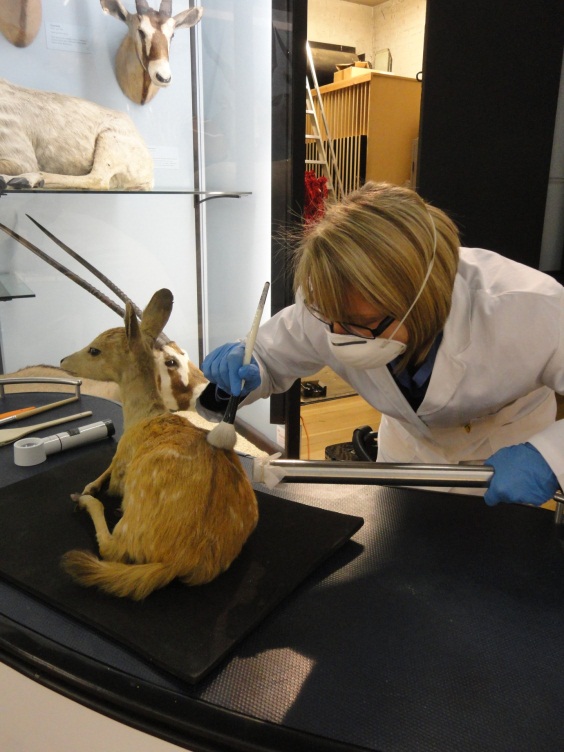A short story sharing how front-of-house staff gained conservation skills and the effect this had on the Natural History Museum Tring, staff and visitor experience.
By Anne Chapman [Operations Manager] with contributions from Kelcie Maydom [Housekeeping Supervisor] and Anne-Marie Bavington [Museum and Security Assistant]

Conservation in action can be seen in this artwork for the Natural History Museum at Tring pop-up banner: © Trustees of the Natural History Museum, London
A few years ago, redevelopment of a large gallery at Natural History Museum at Tring led to a major project to conserve all specimens on public display. The work included building a lift in the public galleries, which created a considerable amount of dust and left all specimens on open display in need of cleaning.
The cleaning and conservation work was undertaken by staff from our South Kensington site and external contractors. The work was costly, time consuming and disruptive to normal gallery operations. For example: the staff doing the cleaning were not based in Tring therefore had a minimum return journey time of three hours and the public gallery had to be closed in order to facilitate the cleaning.
The nature of the work meant that some of our front of house staff were needed to assist and questions arose regarding the need to spend funds on external contractors when we had staff on site willing and able to carry out the work. Following on from this, the Tring management team decided that it would benefit both the taxidermy collections on public display and Tring staff to have a rolling programme of specimen cleaning throughout the public galleries.
Training front-of-house staff
Tring staff worked with the conservation team based at South Kensington to develop a short training session, which was delivered to front of house staff who had expressed an interest in helping with this project.
Our Housekeeping Team Supervisor, Kelcie Maydon, then produced a programme of cleaning work including recording and reporting any conservation issues, utilising the Tring staff that were trained.
This involved ensuring that the programme:
- Fitted around existing staff work schedules (leave, and regular work commitments) and school holidays (our busiest times for all Tring staff, so cleaning and conservation work has to take place outside of the holidays and weekends).
- Kept disruption of the public galleries to a minimum.
An onerous task for the Supervisor, but Kelcie managed to successfully bring all the elements together.
The result: clean specimens
The result of this type of conservation and cleaning training is that members of the Museum and Housekeeping team, Museum and Security Team, and Museum Support (I and L) Team now clean the specimens on a rolling basis when the galleries are quiet, and have managed to achieve a complete clean of all specimens (4000+) within an 18 month period [see the work in action in the image below].
We are now planning to start at the beginning again as it is surprising how much dust a debris accumulates over a relatively short period.

Real life conservation in action: Anne-Marie cleaning one of the small antelope at Tring, in Hertfordshire.
We have noticed several benefits from this conservation initiative:
- Fur is glossy, eyes shine: Specimens on display look so much better.
- Integrated Pest Management [IPM]: We inspect and clean the 4000+ specimens on a much more frequent basis so we have been able to do more thorough checks for insect pests and IPM problems are picked up and dealt with more quickly than in the past.
- Conservation in action: visitors are very interested in the conservation work and Tring staff have been able to explain what they are doing and why – we even had a pop-up banner made to encourage them to ask questions.[see image at the top of the blog]
-
New skills: Tring staff have found their new skills allow a much-appreciated change to their normal routine, and they can see the benefits to the specimens, the Museum and themselves:
“Specimen cleaning gives me great satisfaction in knowing that I am helping to preserve the collections for future generations.”
“Working with the collections gives me great job satisfaction in that you can see the results of your work and know that you are helping to preserve a collection that has been around for hundreds of years.”
“What I enjoy about specimen cleaning is seeing how much detail each animal has compared to when you it in the cases, and having the knowledge of knowing how to clean each specimen depending on what they are made of.”
“I feel I’ve learnt an important skill set that will help protect the museum for many more years to come.”
So, what is our top tip about developing cleaning and conservation training for a variety of museum staff? Make sure you have a person with excellent organisational skills to co-ordinate the project.
If you would like to know more about this project or would like some advice on developing in-house conservation training programmes please speak to Chris Collins, Head of Conservation, the Natural History Museum, Email Chris.
Add new comment